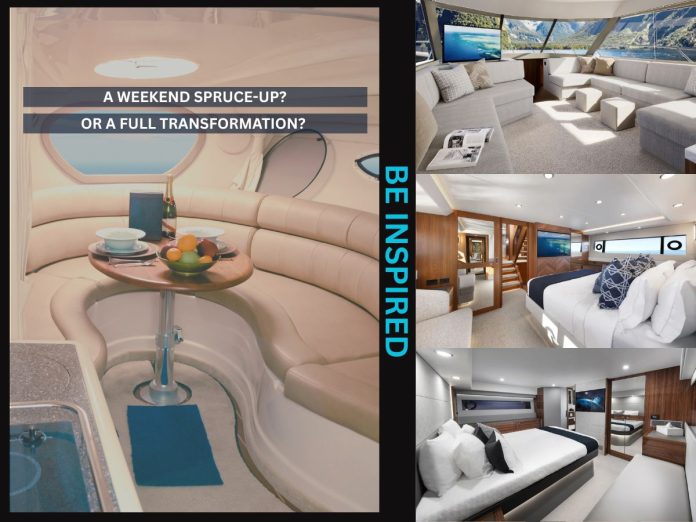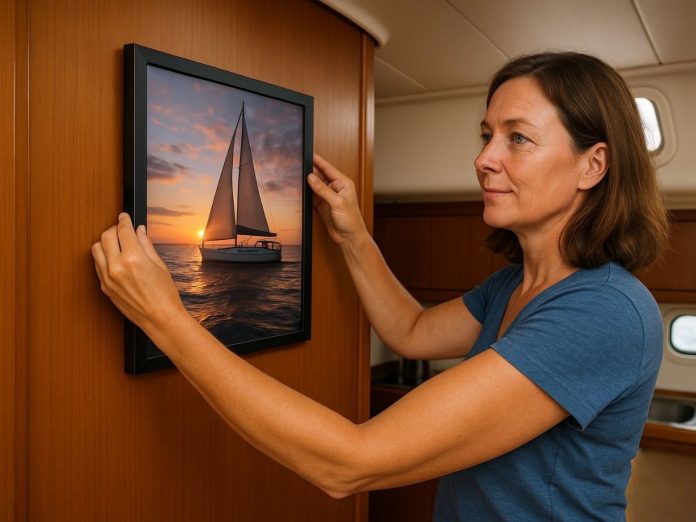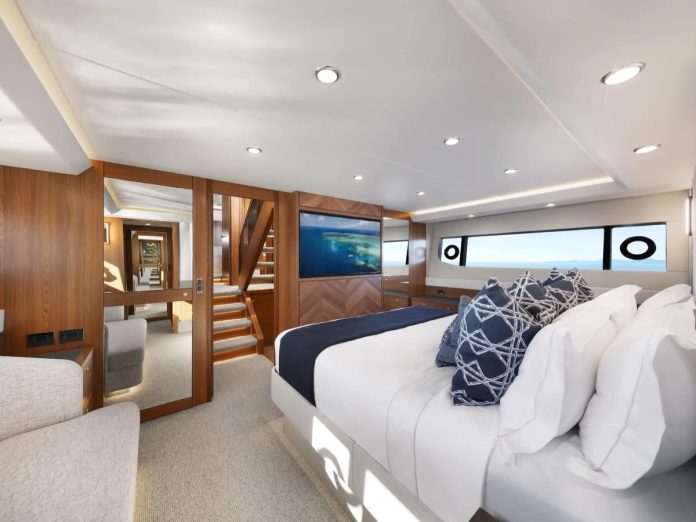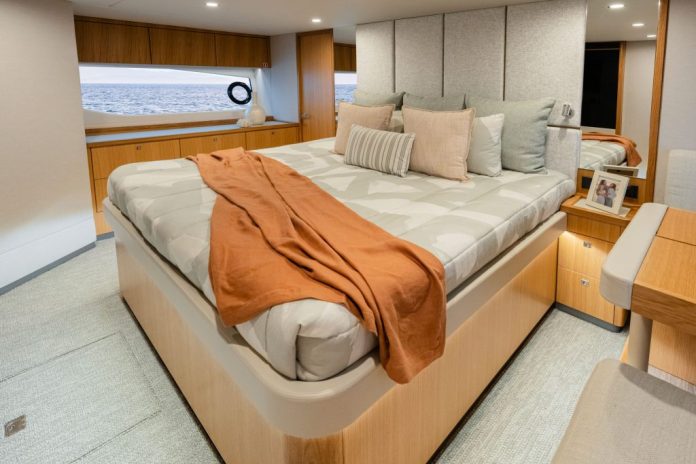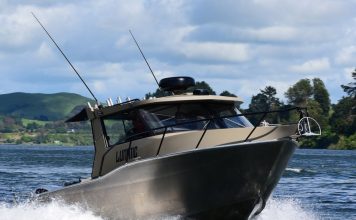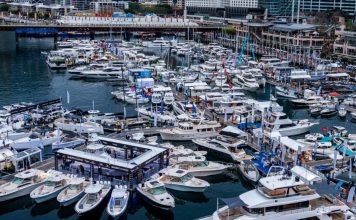When I first began planning this piece, I assumed that most newer yachts—with their crisp lines, contemporary finishes, and airy layouts like the new Maritimo S60—wouldn’t need redecorating. Why tamper with something already so fresh?
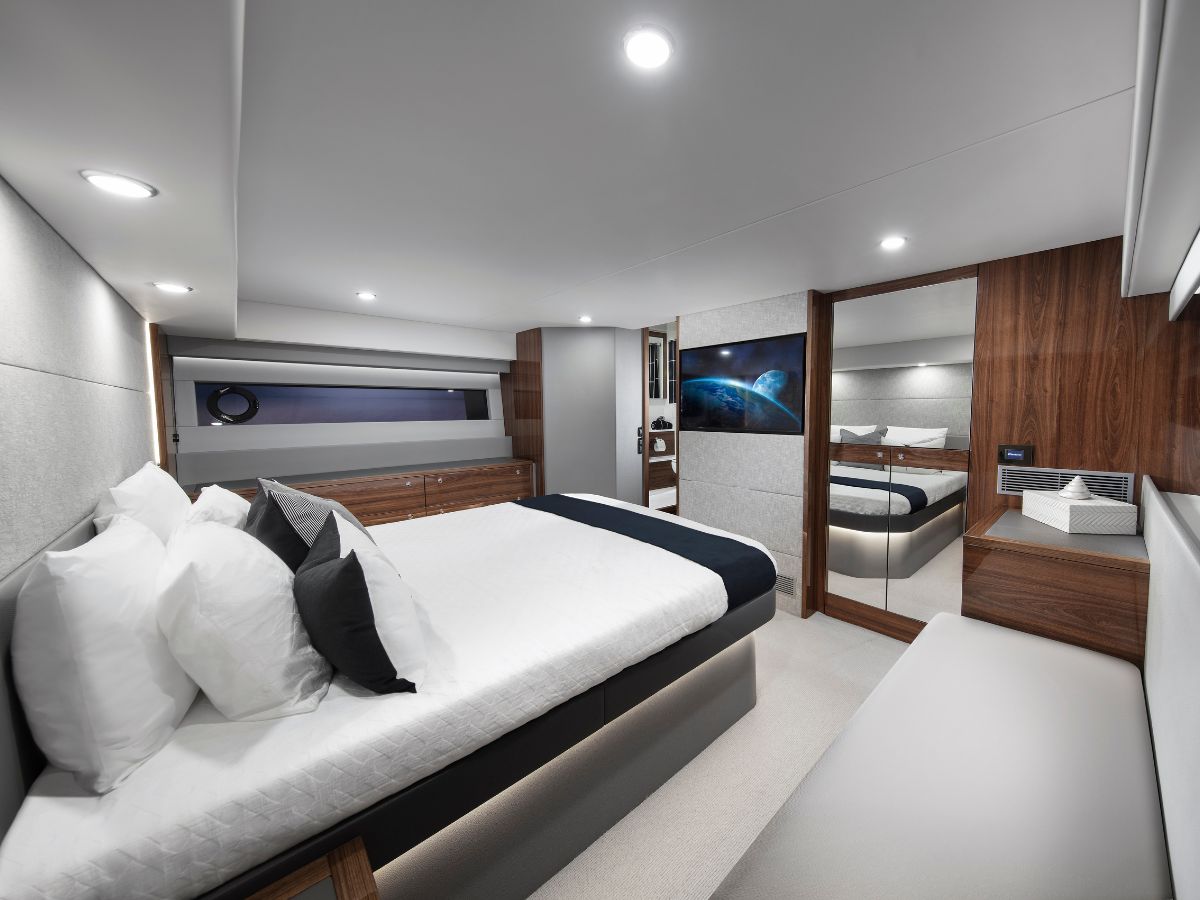
But as I thought back, I could recall plenty of modern yachts whose owners had happily added their own stamp. That realisation made me rethink the original title, “Freshening up your classic yacht.” Whether your pride and joy is a much-loved classic, an older production boat (mine fits this category) or bespoke launch, there are countless ways to breathe new life into her. And how far you go—from a quick spruce-up to a full interior transformation—depends entirely on your time, budget, and appetite for change.
KUUJJUAQ: A Marten 72 that blends speed, style, and sophistication
Take KUUJJUAQ, a 2008 Marten 72 designed by Reichel/Pugh and built by New Zealand’s Yachting Developments. This carbon fibre yacht blends the grit of an offshore racer with the elegance of a luxury cruiser. In 2022, her living quarters were transformed into something worthy of Vogue — chic, minimalist, and high-end, with clean lines, contemporary textures, and an uncommon sense of space for a performance yacht.

A refurb doesn’t always mean tearing out bulkheads or replacing joinery. Sometimes, a few thoughtful touches are enough. In my own 1980s Jeanneau 45, the very first change was removing all the curtains. It instantly brightened the saloon, letting the space breathe in a way I hadn’t expected.
Clear the decks before you start
Before you pick paint colours or fabrics, start with a clean, uncluttered space. Salt, dust, mould, and accumulated gear can dull even the most beautiful interior.
Interior design firm Pocketspace Marine call this an “interior audit” — a systematic look at what works, what needs replacing, and what’s simply in the way. Logical storage systems — baskets, labelled containers, vacuum-sealed bags — can bring visual calm and free up valuable space. Clearing out also exposes problem areas you might otherwise miss, from leaky chainplates to sun-damaged trim.
Repaint, rework, or restore?
Your first major decision is what to do with the timber. Painting in a lighter shade, often white, can lift a space, but it can also invite questions. I once read of a couple who repainted the kitchen doors of their older production yacht—only to find that when they went to sell it years later, every buyer asked what water damage they were hiding.
If your woodwork is structurally sound, consider re-oiling, re-varnishing, or using lighter fabrics to achieve the same effect without paint. Yacht designers Judel/Vrolijk & Co even recommend a low-risk trial: temporarily tape non-woven wallpaper over panels to simulate a lighter look before committing.
Design trends shaping yacht interiors
The best redecorations don’t just follow fashion—they work with the boat’s character. Still, it’s worth knowing where the design world is heading.
Light and space
Small changes can create a surprising sense of space. Painting ceilings lighter than walls draws the eye upward; tone-on-tone palettes in sea blues, sandy beiges, or soft greys feel fresh without overwhelming. Mirrors, securely mounted, can bounce light into shaded corners. Even removing heavy curtains in favour of slim hatch covers simplifies sightlines and lets in more light.
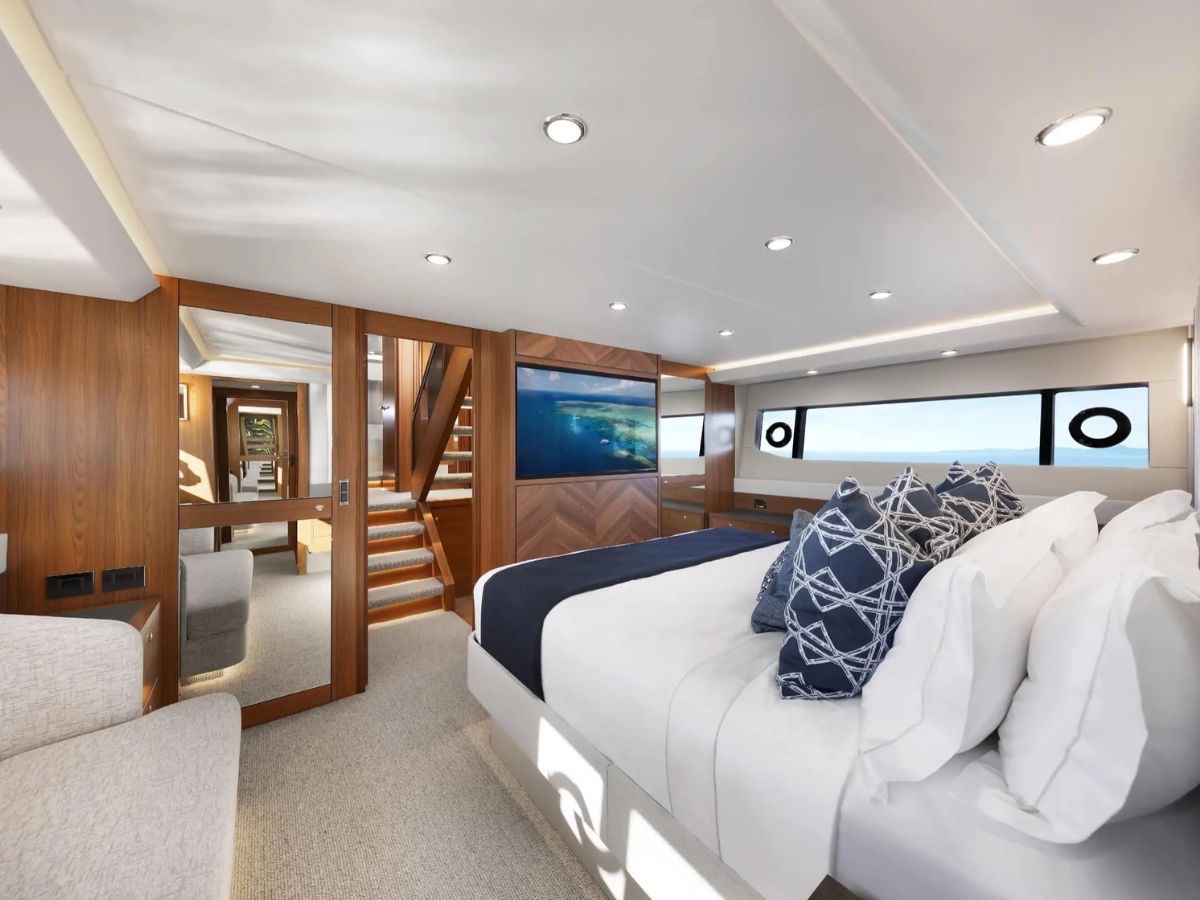
When my husband and I bought our 1980’s 45-foot Jeanneau sailing yacht, the very first thing I did was take down all the curtains. They weren’t needed—without them, the whole space immediately felt lighter, brighter, and more open.
Materials and finishes
Marine-grade fabrics such as Sunbrella or treated linens now come in lighter shades that resist stains, making them practical even in family-friendly boats. Layering textures — timber joinery, linen cushions, wool throws, leather accents — adds depth and warmth. Some owners are using reclaimed timber, marine wallpaper, or light-toned Formica panels to modernise dark-wood interiors without painting.
Sustainability and biophilic design
Eco-friendly materials are finding their way aboard—bamboo, recycled glass, and ‘vegan leathers’. Natural finishes and ocean-inspired hues connect the interior visually and emotionally to the environment outside.
The interior (and exterior) of Kaeā, an Elite 13.8 Sedan, which Boating New Zealand reviewed a in early 2025, was designed by Kim Forkert of Hamilton-based Parkhust Design. Writer Lawrence Schäffler writes, “[y]ou feel a real sense of elegance in these cabins – the rich, dark oak joinery contrasting with the plush, off-white carpets on the floor and cabin sides. It’s a theme that continues throughout the interior, orchestrated by décor specialist Kim Forkert (Parkhurst Design in Hamilton).”
Technology and smart living
Technology no longer has to shout. Italian firm Gallinea’s Nautys range integrates lighting, speakers, and phone charging into height-adjustable tables [Venice Boat Show, 2025], making them ideal for small saloons. The same company has developed a fire-safe charging box for battery-powered toys like Seabobs, a reminder to consider safety whenever adding modern systems to an older vessel.
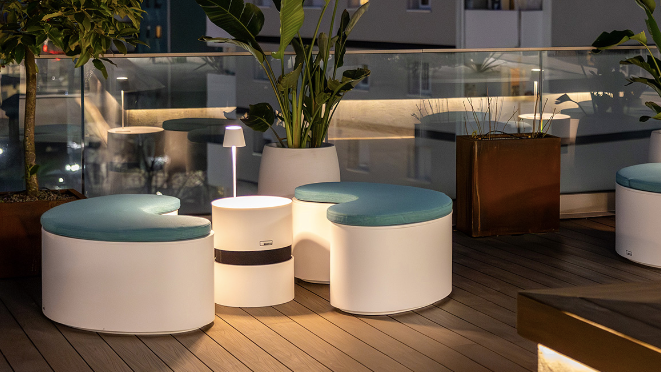
Wellness and relaxation
Wellness touches are increasingly common — from yoga mats that stow under a berth to compact saunas fitted into unused lockers. Spa-style heads with rainfall showers and aromatherapy diffusers turn even a short cruise into a retreat.
Aesthetics and design language
Minimalist, uncluttered spaces with neutral palettes remain popular, but there’s also a swing back to warm, rich tones: walnut, mahogany, deep greens. Curved shapes in furniture and cabinetry create a natural flow. Personalisation is key — cultural motifs, artisan pieces, and mementos from the owner’s travels make an interior truly theirs.
The interior design team behind Maritimo’s luxury motor yachts, Niamh Brennan and Sonya Romeo from The Textile & Design Studio who featured in our recent article, Maritimo Interior Design, have created a system where each owner selects from Oak, Teak, or Walnut timber species, then chooses from four base colour themes—Dune, Haven, Oyster, and Cove. These palettes offer timeless foundations. Clients then layer in soft furnishing options inspired by iconic Australian locations: Kimberley (earthy), Balmoral (monochrome), Hamilton (denim blue), and Hayman (navy).
Romeo notes: “Dune and Cove embrace classic beige and taupe. Haven and Oyster lean toward cooler greys. We offer matching leather and vinyl options to complete the look while supporting resale value.”
Read more about The Textile & Design Studio below.
Maritimo interior design: crafting luxury and personality at sea
Practical considerations
How you use your boat will shape your refit. Racing yachts demand hard-wearing fabrics and secure fittings; liveaboards can prioritise comfort. Tropical cruisers benefit from UV-resistant materials, while cooler climates call for insulation and warm tones.
The Pacific 62 — reviewed in Boating New Zealand back in April, is a good case study. Custom cabinetry makes every centimetre count, and built-in bottle and cup holders keep the saloon table clutter-free and bump-free—proof that practical can also be polished.
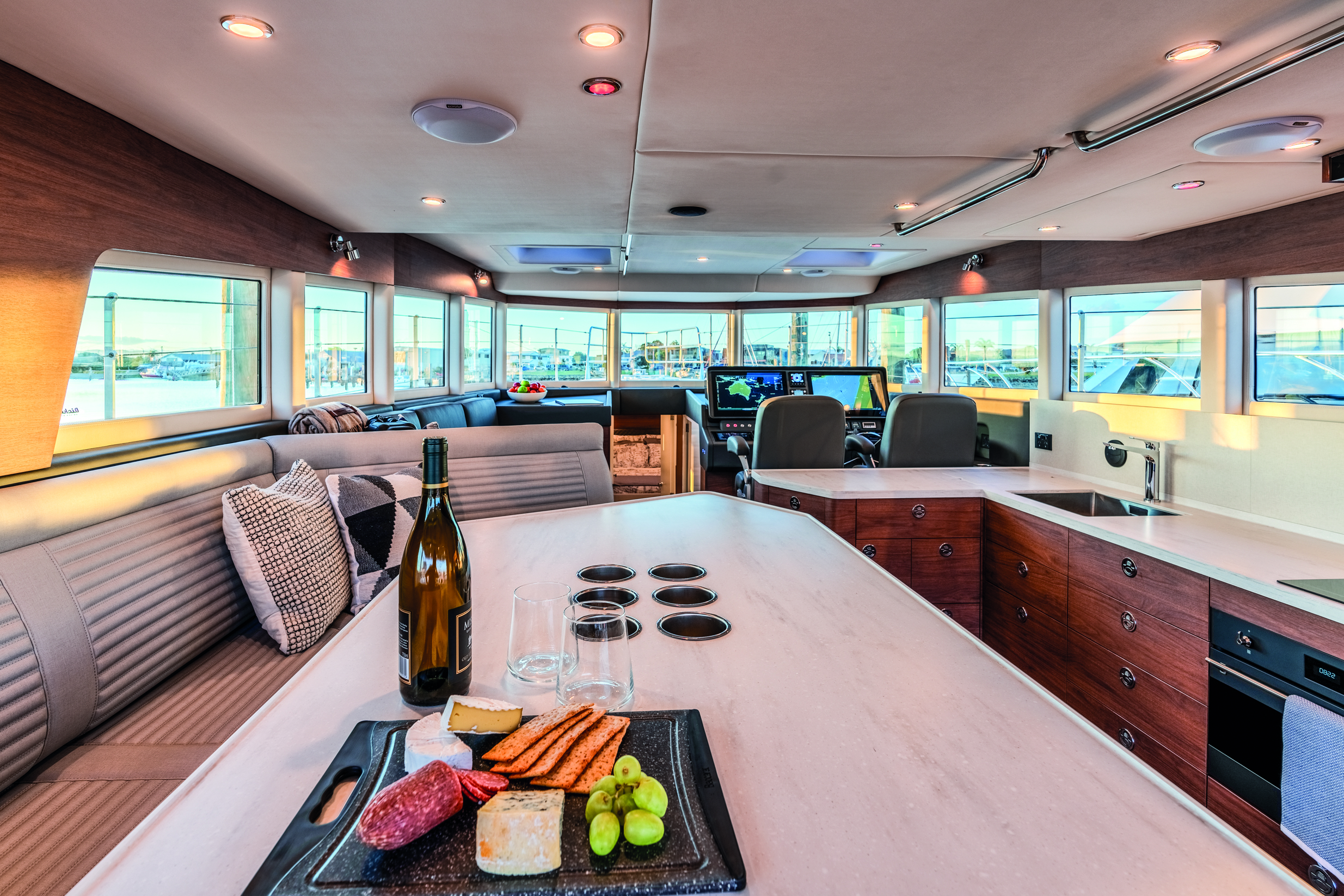
Decor and styling
Accents are where you can have fun. Cushions, rugs, and throws are easy to swap with the seasons. Nautical cues — brass clocks, framed charts — give personality without overwhelming the space. Greenery, whether real or artificial, brings life (just secure it for sea).
Riviera’s new interior furnishings collection redefines luxury at sea
Balancing old and new
Restraint is the watchword. Keep the details that define your boat’s era — a curved companionway ladder, original brass portholes, or a saloon table worn smooth by decades of meals — and choose modern touches that complement them.
Define the scope early: is this a cosmetic refresh or a structural overhaul? Map your available time — weekends, haul-out season — and prioritise high-impact, low-disruption changes such as lighting, upholstery, and wall finishes.
A labour of love
Redecorating a classic, older or ‘modern’ yacht is as much about preserving stories as it is about updating style. The best interiors respect the past while embracing the present—lightening a 70s saloon without losing its timber warmth, or adding a tech-integrated table to a 1930s launch without breaking its lines.
A great real-world example comes from Sailing Magic Carpet, the well-known YouTube channel documenting the adventures of Maya and Aladino. Their current boat, Magic Carpet II, is a Cape George 36 built in 1982 in Port Townsend, Washington. The hull and ballast came from Cape George Marine Works, while the original owner completed the rest of the build. After years of cruising, the interior was showing its age, so the pair undertook a careful refurbishment — one that respected the yacht’s heritage while making it more functional for their liveaboard life. Their updates combined fresh fabrics, improved storage, and subtle design tweaks that brightened the saloon without losing the warm, traditional feel that defines a Cape George. It’s a reminder that even a classic with good bones can benefit from thoughtful modern touches.
Done well, it’s a transformation that feels inevitable — as if the boat has always been this way.
10 quick upgrades for your yacht interior |
|---|
| 1. Swap out the curtains Heavy drapes can make a cabin feel smaller and block light. Try slim hatch covers or Roman blinds in a light, UV-stable fabric. On our 1980s Jeanneau, removing the curtains instantly opened the space and made it brighter. |
| 2. Change the lighting Replace yellowed halogens with warm-white LED strips or downlights. They’re energy-efficient, cooler to run, and instantly modernise the mood. Sailing Magic Carpet’s saloon refit used LED rope lighting to soften shadows and highlight timber grain. |
| 3. Upgrade your upholstery Fresh cushion covers in marine-grade fabrics like Sunbrella can change the entire look of a saloon. Pick tones that work with your joinery — sandy beige for teak, slate grey for walnut. |
| 4. Refinish the timber A simple re-oil or satin varnish brings depth and life back to tired woodwork without losing its character. The Cape George 36 Magic Carpet II kept her original grain but gained a richer, warmer tone. |
| 5. Add mirrors in the right places A small, well-placed marine-safe mirror can make a compact head or saloon feel twice the size. Just remember to secure it with brackets or adhesive pads. |
| 6. Update soft furnishings Throws, rugs, and scatter cushions add comfort and colour. Change them seasonally — blue and white in summer, richer earth tones in winter. |
| 7. Modernise the galley hardware Swapping old taps, drawer pulls, or cabinet handles for stainless or matte black fixtures is a quick, affordable way to lift the look. |
| 8. Build in multi-use storage Custom cabinetry, like the Pacific 62’s bottle holders built into the saloon table, keeps clutter at bay and makes every detail feel considered. |
| 9. Introduce greenery A low-maintenance plant (real or faux) in a secured pot brings freshness below decks. Succulents work well for liveaboards, while faux trailing plants add softness to bulkhead shelves. |
| 10. Refresh the bedding Crisp, colour-coordinated bedlinen in the cabins makes overnight guests feel welcome and adds a boutique-hotel feel. Layer with a lightweight throw for summer or a quilt in cooler months. |








